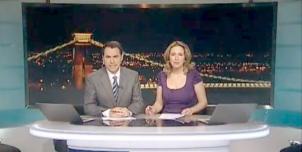Full Freeview on the Mendip (Somerset, England) transmitter
| Google Streetview | Google map | Bing map | Google Earth | 51.237,-2.626 or 51°14'12"N 2°37'33"W | BA5 3LB |
The symbol shows the location of the Mendip (Somerset, England) transmitter which serves 720,000 homes. The bright green areas shown where the signal from this transmitter is strong, dark green areas are poorer signals. Those parts shown in yellow may have interference on the same frequency from other masts.
This transmitter has no current reported problems
The BBC and Digital UK report there are no faults or engineering work on the Mendip (Somerset, England) transmitter._______
Digital television services are broadcast on a multiplexes (or Mux) where many stations occupy a single broadcast frequency, as shown below.
64QAM 8K 3/4 27.1Mb/s DVB-T MPEG2
DTG-12 QSPK 8K 3/4 8.0Mb/s DVB-T MPEG2
H/V: aerial position (horizontal or vertical)
Which Freeview channels does the Mendip transmitter broadcast?
If you have any kind of Freeview fault, follow this Freeview reset procedure first.Digital television services are broadcast on a multiplexes (or Mux) where many stations occupy a single broadcast frequency, as shown below.
64QAM 8K 3/4 27.1Mb/s DVB-T MPEG2
DTG-12 QSPK 8K 3/4 8.0Mb/s DVB-T MPEG2
H/V: aerial position (horizontal or vertical)
Which BBC and ITV regional news can I watch from the Mendip transmitter?

ITV West Country News (East) 0.9m homes 3.4%
from Bristol BS4 3HG, 23km north (11°)
to ITV West region - 61 masts.
All of lunch, weekend and 50% evening news is shared with West Country (West)
Are there any self-help relays?
| Cheddar | Transposer | 15 km E Weston-super-Mare | 1674 homes |
| Luccombe | Active deflector | 6 km w Minehead | 38 homes |
How will the Mendip (Somerset, England) transmission frequencies change over time?
| 1984-97 | 1997-98 | 1998-2010 | 2010-13 | 2013-18 | 2013-17 | 27 Feb 2018 | |||
| C/D E | E | E | C/D E | C/D E T | W T | W T | |||
| C30 | _local | ||||||||
| C32 | BBCA | ||||||||
| C33 | com7 | com7 | |||||||
| C34 | D3+4 | ||||||||
| C35 | com8 | com8 | |||||||
| C36 | ArqB | ||||||||
| C37 | C5waves | C5waves | |||||||
| C48 | SDN | SDN | SDN | SDN | |||||
| C49tv_off | BBCA | BBCA | |||||||
| C51tv_off | LBS | LBS | |||||||
| C52tv_off | ArqB | ArqB | ArqB | ||||||
| C54tv_off | C4waves | C4waves | C4waves | D3+4 | D3+4 | D3+4 | |||
| C55tv_off | com7tv_off | ||||||||
| C56tv_off | ArqA | ArqA | ArqA | COM8tv_off | |||||
| C58tv_off | BBC1waves | BBC1waves | BBC1waves | BBCB | BBCB | BBCB | |||
| C61 | ITVwaves | ITVwaves | ITVwaves | BBCA | |||||
| C64 | BBC2waves | BBC2waves | BBC2waves |
tv_off Being removed from Freeview (for 5G use) after November 2020 / June 2022 - more
Table shows multiplexes names see this article;
green background for transmission frequencies
Notes: + and - denote 166kHz offset; aerial group are shown as A B C/D E K W T
waves denotes analogue; digital switchover was 24 Mar 10 and 7 Apr 10.
How do the old analogue and currrent digital signal levels compare?
| Analogue 1-4 | 500kW | |
| Analogue 5 | (-6dB) 126kW | |
| SDN, ARQA, ARQB, BBCA, D3+4, BBCB | (-7dB) 100kW | |
| com7 | (-8.4dB) 72.4kW | |
| com8 | (-8.6dB) 69.1kW | |
| Mux 1*, Mux 2*, Mux A*, Mux B*, Mux C*, Mux D*, LBS | (-17dB) 10kW |
Which companies have run the Channel 3 services in the Mendip transmitter area
|
|
Thursday, 12 April 2012
T
The Wakefield7:19 AM
Berkeley
Hello there, Chris.SE! ^_^ I didn't bother with the Postcode Reception Predictor because until just after this Power Up we've had more than adequate reception here, and checking it now we're still very much in the predicted signal area. Even when 52 & 56 were on their older channel numbers at lower power we received them perfectly. Before the Power Up everything was perfect, on the day of the Power Up everything was perfect, it was just a couple of days after the Power Up where everything fell apart. I thought it might be an engineering issue because there was a Transmitter Engineering post on the 26th of March that didn't give any specific dates, and Gareth Smart said something on the 1st about there being weak signal until Friday the 6th. (I'd be interested to know if you've still got weak signal now, Gareth ^_^) If it's not an engineering issue then I just don't understand what's going on, or why it's only affecting channels 61 & 56 the way it is. Any ideas, Chris.SE? ^_^; Is there anyone I can complain to about this?
| link to this comment |
The's: mapT's Freeview map terrainT's terrain plot wavesT's frequency data T's Freeview Detailed Coverage
M
Mike Dimmick1:18 PM
The Wakefield: If the problems started at the last retune/power up, chances are that the combined signal strength of all the services is now too large. If you have an amplifier or booster, try removing it or turning it down. If not, you should try adding an attenuator to reduce the overall signal levels.
If you're using an amplified splitter to feed more than one TV, consider replacing it with a passive splitter instead.
| link to this comment |
M
Mike Dimmick1:31 PM
Dave Lindsay: Yes, I mean C31-C37.
'What will it be used for?'
That's really the question.
The issue that has come up is that there is now pressure, mostly from other countries, to release C48-C60 for mobile phone use. This range of frequencies ('700 MHz band') has already been released for LTE in the USA and Japan. Countries without a developed wired telephone and broadband network are interested in also using it, but at the moment it's not permitted anywhere in ITU Region 1 (Europe, Middle East and Africa).
Making mobile phone/wireless broadband 'co-primary' with broadcasting has now officially been put on the agenda for the next World Radiocommunications conference, scheduled for 2015. This was one of the last decisions at WRC12 in February. Ofcom have responded by consulting on what the future of UHF spectrum is. The consultation is framed very much on the idea of clearing the channels for wireless data.
Clearly there are a lot of transmitters using the 700 MHz band, and Mendip is one of the major ones. If this happens, *all* Mendip muxes would have to move somewhere. Thanks to the clearances at DSO, there is a gap from C31-C38 but that's only 8 channels and we have to clear 12. So a complete replan may be on the cards.
DVB-T is now quite old technology - 15 years, nearly - and we could get greater capacity per multiplex with DVB-T2, and also reduced bitrates (for the same resolution and picture quality) with MPEG-4 AVC/H.264 rather than MPEG-2. It would be possible to get the same number of channels into fewer muxes with DVB-T2, but of course everyone would have to get a Freeview HD box to replace their old box, or to add to their non-compatible TV. HD gear is selling quite well but it'll be a few years before it's near saturation and DVB-T could be switched off.
Ofcom's consultation is at Ofcom | Securing long term benefits from scarce spectrum resources - A strategy for UHF bands IV and V and Arqiva's high-level thoughts on how to replan are at http://stakeholders.ofcom….pdf .
The extra three muxes are still listed as a possibility, but the chances are we wouldn't be able to secure international clearance to do it - our neighbours generally only have 8 layers or fewer, and us seeking to replan our eight (which includes cleared channels at many locations, so really six) to nine won't be popular.
| link to this comment |
Friday, 13 April 2012
T
The Wakefield7:33 AM
Hello there, Mike Dimmick! ^_^ I go through periods of more than enough signal to periods of barley any signal (Mostly affecting channels 61 & 56) at completely random times of day, (There's been no pattern that I've been able to deduce) but I didn't start getting signal problems until a few days after the retune. Is that a symptom of too much amplification as I understood that too much amplification gave you no signal at all and not sporadic signal? ^_^;
| link to this comment |
T
The Wakefield7:47 AM
I've just tried my primary TV with less amplification, Mike Dimmick, and it just resulted in less signal than I already had. ^_^;
| link to this comment |
Sunday, 15 April 2012
M
Mower Man9:31 AM
Wakefield, we are in the centre of the levels with clear line of sight to the menip mast and we have the same problem with channel 61 dropping in and out from strong signal to almost none. Mostly it is in the morning but not always.
| link to this comment |
Monday, 16 April 2012
M
MAPMAN12:09 AM
Hello
Earlier this week visited elderly relations in Clevedon. They are heavy users of FREEVIEW and are very nearly within sight of Mendip transmitter. They use new aerial. Despite frequent retunes on one TV and two Freeview boxes they have never had very good Freeview reception - fairly frequent picture drop outs on BBC and ITV channels and recently have lost Channel 11 and Sky News completely (No signal). Six months ago was informed that problems were because of low power transmissions on several MUXs but I believe this has now been rectified. Problems are exactly the same when old aerial used and cables interchanged. I see others are also having these problems - any advice please on what can be done ? We do not have these problems in Hampshire even though transmitter is further away and signals are weaker.
Thanks
| link to this comment |
T
The Wakefield4:28 AM
Thanks for confirming that this isn't all just me going mental, Mower Man! ^_^; What's the Signal Strength of you Channel 56 like now compared to how it was on Channel 67?
I'm narrowing things down then because this isn't an Aerial problem, an Amplification problem, a Cabling problem, an equipment problem, and from what I can tell there aren't any other Transmitters close to us broadcasting on the same Channels to cause a Signal Overlap. Does anyone think that sacrificing a Goat to Satan would do anything for me? ^_^;
| link to this comment |
B
Ben Ward11:17 AM
Melksham
Thanks for the supportive comments, chaps.
Getting an attentuator hasn't helped me, unfortunately. I am still inclined to think that its the equipment; the Humax receiver works fine, the other 3 receivers are in fact getting worse, with a scrambled signal, or no signal at all...
| link to this comment |
Ben's: mapB's Freeview map terrainB's terrain plot wavesB's frequency data B's Freeview Detailed Coverage
Ben Ward: It's possible that other leads are interfering with the signal carried along the aerial lead. Notably HDMI and USB leads
If they are in close proximity, try moving them away from one another and see if the signal improves.
| link to this comment |
Select more comments
Your comment please!






